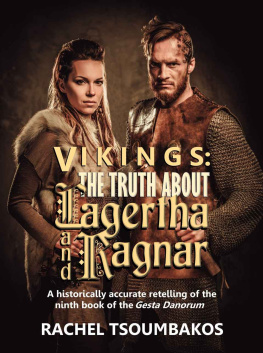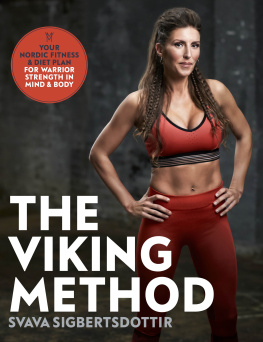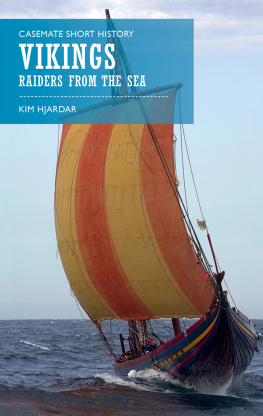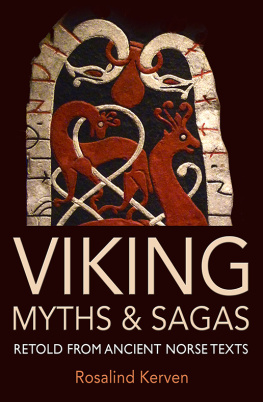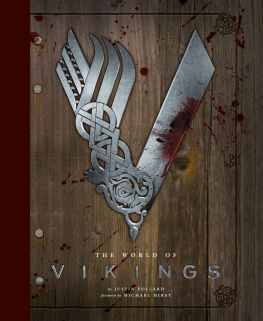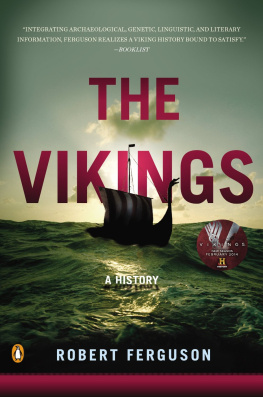THE VIKINGS AND THEIR AGE
COMPANIONS TO MEDIEVAL STUDIES
series editor: Paul Edward Dutton
MAP OF THE VIKING WORLD
THE VIKINGS AND THEIR AGE
by Angus A. Somerville
and R. Andrew McDonald
Copyright University of Toronto Press Incorporated 2013
Higher Education Division
www.utppublishing.com
All rights reserved. The use of any part of this publication reproduced, transmitted in any form or by any means, electronic, mechanical, photocopying, recording, or otherwise, or stored in a retrieval system, without prior written consent of the publisheror in the case of photocopying, a licence from Access Copyright (Canadian Copyright Licensing Agency), One Yonge Street, Suite 1900, Toronto, Ontario M5E 1E5is an infringement of the copyright law.
LIBRARY AND ARCHIVES CANADA CATALOGUING IN PUBLICATION
Somerville, Angus A., 1943
The Vikings and their age / Angus A. Somerville and R. Andrew McDonald.
(Companions to medieval studies series ; v. 1)
Includes bibliographical references and index.
Also issued in electronic format.
ISBN 978-1-4426-0522-0 (paperback)
ISBN 978-1-4426-0762-0 (cloth)
1. Vikings. 2. Civilization, Viking. 3. VikingsSources.
I. McDonald, Russell Andrew, 1965 II. Title. III. Series: Companions to medieval studies series ; v. 1
DL65.S64 2013 948022 C2012-908017-9
We welcome comments and suggestions regarding any aspect of our publicationsplease feel free to contact us at
North America | UK, Ireland, and continental Europe |
5201 Dufferin Street | NBN International |
North York, Ontario, Canada, M3H 5T8 | Estover Road, Plymouth, PL6 7PY, UK |
ORDERS PHONE : 44 (0) 1752 202301 |
2250 Military Road | ORDERS FAX : 44 (0) 1752 202333 |
Tonawanda, New York, USA, 14150 | ORDERS E-MAIL : |
ORDERS PHONE : 18005659523
ORDERS FAX : 18002219985
ORDERS E-MAIL :
Every effort has been made to contact copyright holders; in the event of an error or omission, please notify the publisher.
The University of Toronto Press acknowledges the financial support for its publishing activities of the Government of Canada through the Canada Book Fund.
Printed in Canada
For our families
CONTENTS
ILLUSTRATIONS
Photos
Maps
TEXT BOXES
ACKNOWLEDGMENTS
We are grateful to the University of Toronto Press for inviting us to write this book. In particular we thank Natalie Fingerhut for once again guiding the book through the press with professionalism and patience, and Paul Dutton for invaluable comments and expert guidance. As with The Viking Age: A Reader, the book would not have been possible without the many students who have populated our courses on Viking history and Old Norse over the years at Brock University, and we hope that this little book may prove useful to future students in those classes. We are grateful to Loris Gasparotto for producing the maps, and to Margaret Stephenson and Candice Bogdanski for permission to use two of their images. As ever, our biggest debt is to our families, who continue to live with the Vikings: Barbara, Anna, and Clare; Jacqueline, Emma, and Colin.
INTRODUCTION
This book provides a brief introduction to the Viking Age and to the results of scholarship on the period. The Vikings and Their Age relies heavily on the same sources and resources as our volume The Viking Age: A Reader, which presented a variety of documents relating to the Vikings and the Viking Age. While this book provides references to relevant passages in the Reader, it is itself a guide to the historical and scholarly issues involved in the study of the Viking Age. It contextualizes the material of the Reader so that students may approach the documents that the Reader contains with a better understanding of how and where they fit into the broader picture of the Vikings and their time.
We begin with a brief overview of the chronology and major themes of the Viking Age in contains brief biographies of several interesting and significant figures, both to illustrate the breadth and diversity of the Viking experience and to provide additional information on some of the characters who crop up frequently in the Reader.
Any study of the Vikings requires a multi-disciplinary approach, so we provide insights and evidence from disciplines such as archaeology, philology, and linguistics. However, our main focus is on the written record. offers a case study in reading and interpreting a short document pertinent to the Viking Age. The Afterword steps back to provide some brief thoughts on what impact the Vikings had on medieval Europe, and the volume concludes with what we hope are some useful reflective aids and tools for students.
OUR USE OF THE TERM VIKING
The usefulness of the term is the subject of debate among academics, some of whom avoid its use entirely because of its infrequent use in the Viking Age (see ). We employ the term in its widely accepted sense as a descriptor for the peoples of Scandinavia in the period from the late eighth to the eleventh centuries, not only for those who, by undertaking seaborne raiding, were Vikings in the contemporary sense of the word (see Glossary). The terms Norse, Norsemen, and Northmen are used interchangeably throughout.
A WORD ON VIKING NAMES
The Vikings did not use family names or surnames. Individuals were designated by a given name followed by a patronymic or, less commonly, a matronymic. A patronymic was formed by taking the fathers name and adding the suffix -son or -dttir (son/daughter). Thus, Egil Skallagrimsson is Egil, the son of Skallagrim, and his brother is Thorolf Skallagrimsson. Egils son is Thorstein Egilsson, and his daughter is Thorgerd Egilsdttir. (In this text, following the practice of the Reader, we use the anglicized form Egilsdaughter.) Matronymics could also be used, especially in cases where the father died young. The Orcadian chieftain Svein Asleifarson (see ) illustrates this form; his mother was Asleif. The system is still used in Iceland today, where telephone directories list individuals by first names.
Identification by epithet is also common. Sometimes the meaning of the epithet is puzzling, as with the Danish king Harald Bluetooth or Ivar the Boneless, one of the leaders of the Great Heathen Army that invaded England in the 860s. Egil Skallagrimssons grandfather, Ulf, was known as Kveldulf (Evening-Wolf) because he was thought to be a shape-shifter who became a wolf by night. Nicknames and epithets imprint some individuals from the Viking Age indelibly on our memories: Asgeir Scatter-Brain, Aud the Deep-Minded, Eirik Ale-Lover, Eystein Foul-Fart, Eyvind the Plagiarist, Gunnlaug Serpent Tongue, Halfred the Troublesome Poet, Olvir Child-Sparer, Sigtrygg Silken-Beard, Thorbjorg Ship-Breast, and, perhaps topping them all Thorgils Mound-Shitter.
A NOTE ON LANGUAGE
As is usual, the names of persons are anglicized: Egill appears as Egil, and Gurn as Gudrun.
Only two symbols from Old Norse are likely to cause confusion on the rare occasions when they are used here: , (eth), pronounced th as in
Next page


